Wednesday, December 15th, 2021 by Julian Karsunky
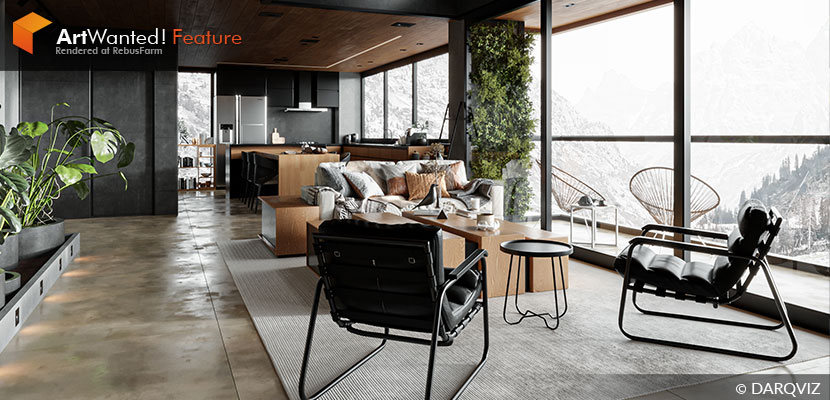
Architectural visualization is both a commodity and an artform, global industry and deeply personal expression, it is business and pleasure. While these lines are always blurry, rarely do they converge as seemingly as in the portfolio of DARQVIZ Studio. Founded last year by construction manager Dennis Grimm and CGI artist Renato Aguilar, the company's approach is visionary and disruptive, blending state-of-the-art services and passion projects.
In our interview, Renato and Dennis discuss their professional history, social responsibility, and using architecture as a story-telling device.
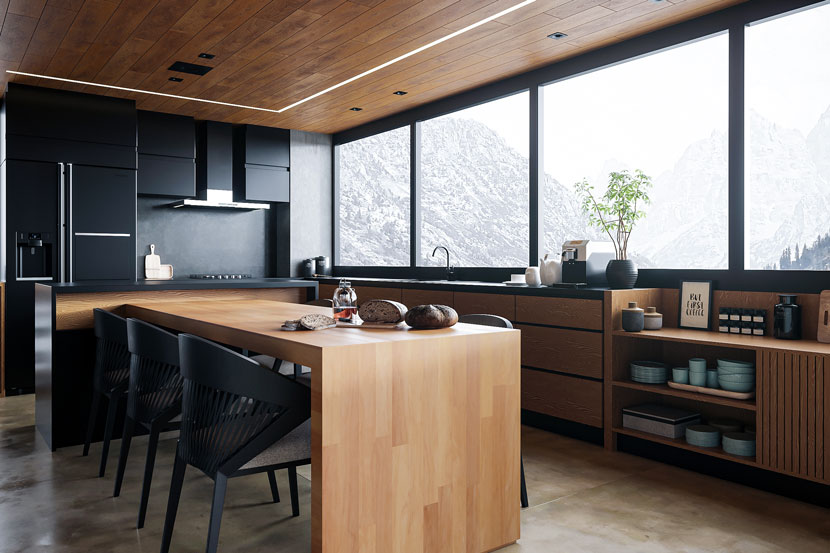 This interior, properly titled 'Arriving', marks the studio's first completed archviz scene.
This interior, properly titled 'Arriving', marks the studio's first completed archviz scene.
Hi Dennis, hi Renato, thanks for joining us! To start things off, please introduce yourselves to our readers.
Dennis: Thanks for having us! My name is Dennis Grimm, and I am 26 years old. I was born in Southern Germany, but in the past, I have lived in different places like Mexico and Austria.
Renato: Hello guys, I am Renato Aguilar, 24 years old and I was born in Guatemala City. Like Dennis, I have lived in many countries such as Colombia, Honduras, Guatemala, Mexico, and the Dominican Republic.
Let's talk more about your professional background. Renato, do you recall when and how you first consciously encountered CGI?
Renato: Yeah, I'll never forget my first rendering class. It was in 2018, during my foreign exchange program in Colombia. The instant I realized what can be achieved with 3D modeling and proper rendering skills, I fell in love.
When and why did you then decide to pursue a professional career as a 3D artist?
Renato: While I knew I loved it from the get-go, the thought of turning it into a career did not occur to me until last year. I had just quit my job when Dennis reached out to me and proposed that we start our own business. So we decided to start a rendering studio, focusing on images and virtual tours.
What training or education do you have?
Renato: I completed the VizAcademy training at the end of 2020. Currently, I am doing the Rendermind 2.0 program by Ander Alencar as well as undergoing certification at Corona Academy. In terms of traditional education, I took a five-month class in 2018 called "Arquitectura digital avanzada". Of course, there are also so many great free resources available on YouTube and such, so self-learning is always a viable option as well.
Dennis, how has your background in construction management shaped your understanding of architecture and the archviz industry?
Dennis: As a construction manager, you get a highly technical perspective on how things are built in reality. A very logical – might I say German? – approach to architecture, which helps us to achieve photorealism by virtually mapping what would be built on an actual construction site. Archviz is just like construction, only with more freedom to design and fewer subcontractors to worry about.
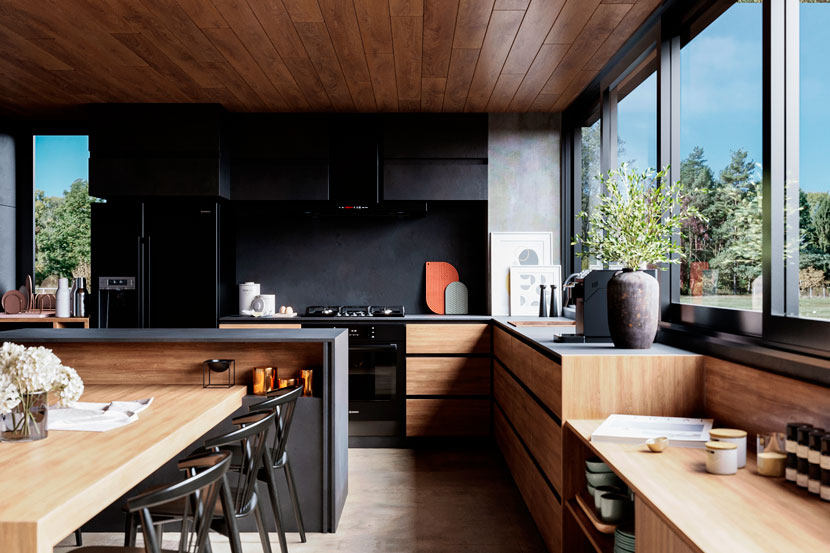 A closer look at the kitchen area of the 'Arriving' interior.
A closer look at the kitchen area of the 'Arriving' interior.
Tell us about DARQVIZ Studio, the company's history, field of work, and overall philosophy! When and under what circumstances was the studio founded?
Dennis: DARQVIZ was established at the outbreak of the pandemic last year. Instead of being forced into a standstill, we tried to see it as an opportunity, to use this crisis as a steppingstone to start doing what we love. Although we are thousands of kilometers apart, separated by the Atlantic Ocean, Renato and I digitally agreed on incorporating the studio in Germany and officially embarked on this journey together.
DARQVIZ refers to itself as a "nomad studio". Can you explain your approach and overarching vision as an archviz company?
Dennis: We believe that everything in the world is connected, and so our studio too shall state an example that there are no borders. While I call Europe my home, Renato currently lives in the Dominican Republic. Luckily, the ongoing digital globalization allows us to work together as a team without sharing the same office. Communication is key, and technology makes it possible to collaborate remotely on projects around the globe – even for a small studio like ours.
What services do you provide?
Dennis: We are passionate about interior design and rendering; another focus lies on product visualizations and animations. Spearheading technological advances, we developed an interactive walkthrough solution using Unreal Engine that can be instantly called up from any desktop through cloud streaming.
Who are your clients and target markets?
Dennis: Our client base – we prefer to consider them our partners – is very diverse in terms of industries and projects. Generally speaking, we co-create impactful visuals with everybody who needs to present a design without having it brought to life yet. Partnering up with real estate developers, architects, construction companies, and even product designers and manufacturers, we realized plenty of fruitful collaborations throughout our first year.
As founder and CEO, what are your general responsibilities and daily tasks at DARQVIZ?
Dennis: Keeping all strings together and making myself responsible for every action our studio takes, that most adequately summarizes my work. Besides managing daily operations like project management, team coordination, and client communication, I also strongly focus on the strategic tasks to grow DARQVIZ. Business development including PR & marketing, project acquisition, and tactical orientation of the studio is a huge part of my responsibilities.
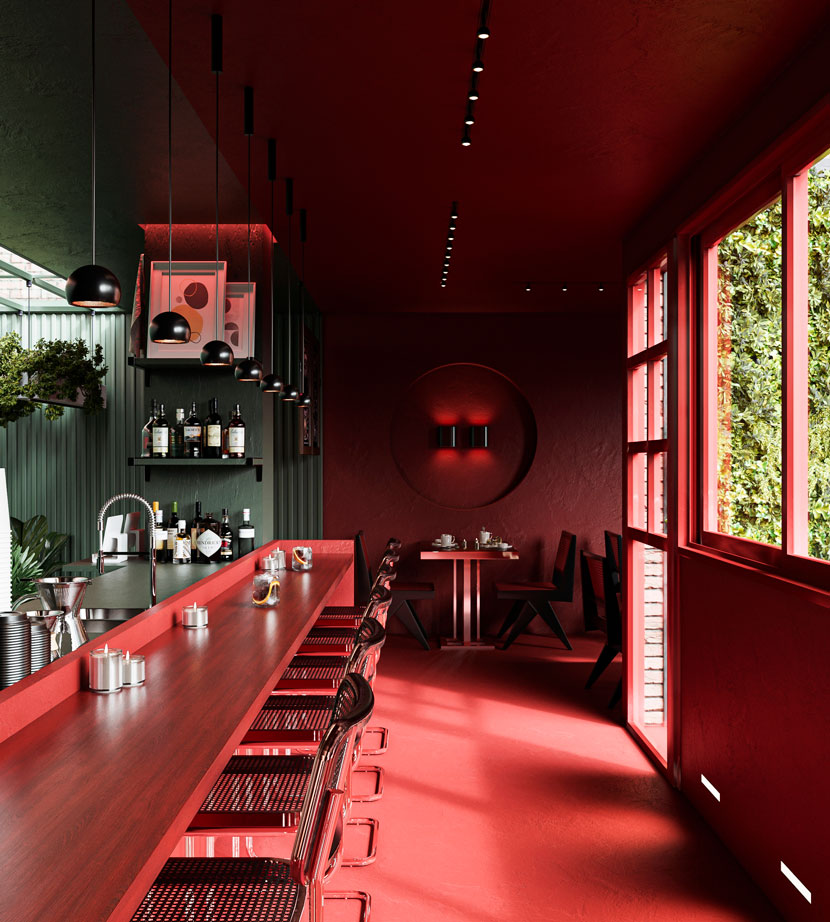 This modern and playful bar environment showcases the smart lighting systems courtesy of Supermodular.]
This modern and playful bar environment showcases the smart lighting systems courtesy of Supermodular.]
Let us dive a bit deeper into your approach to archviz and your overarching creative vision. On your website, you mention a desire to "disrupt architectural visualization"? Can you elaborate on this point and how it translates to your work?
Renato: Our main goal is to always approach archviz in a different way, using colors, models, and materials that aren't usually seen in archviz. Reinvent some of the work that is already done, and view it through our eyes, give it our unique spin. We try to strike a balance of what can and cannot be disruptive: when it comes to doing images for commercialized business, you obviously want to prioritize your customer's requirements above all else. On the other hand, we have free reign on internal projects. A scene like 'Fainted Hope' perfectly encapsulates our goals and what we mean by "disrupt architectural visualization".
You specifically mention video game software as a tool with the power to fundamentally change the construction industry. Following this thought, what does the future look like?
Renato: I think game development tools like Unreal Engine and Unity have a bright future in archviz. Animations and images are excellent ways to present projects, sure. But exploring the whole interior of your future house or apartment, and being able to change materials, finishes, and light in real time? Now that's amazing! Expensive, of course, but amazing. I'm not saying it will completely replace our current toolset, images and animations will always have their place. But it's a whole new 3D world and only RAM is the limit.
Is there a specific design philosophy or architectural school of thought DARQVIZ adheres to? What inspires you and your team of 3D artists?
Renato: No there isn't. We have worked with different artistic movements and design trends and loved them all. Personally, I like minimalism, high and low contrast colors, and Nordic interiors, just to name a few. Although, to be honest, I do not consider myself an expert in this matter, so I most likely would not even be able to follow the strict ruleset of specific design philosophy, if such a thing even exists. We take the elements we like and try to make them ours, respecting their own identity as best as possible.
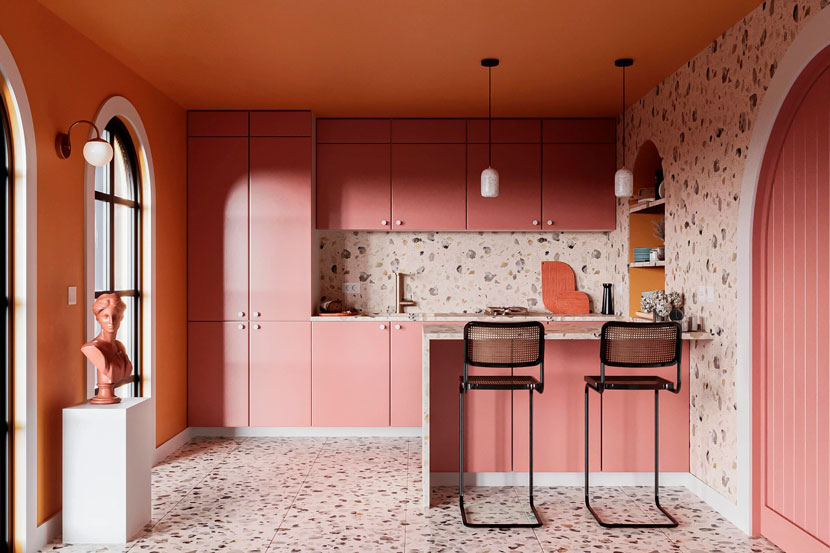 Renato cites this 'Pink & Orange' collaboration with WYE Design as one of his personal favorites.
Renato cites this 'Pink & Orange' collaboration with WYE Design as one of his personal favorites.
Describe your profile as a CG artist! Where does your fascination with architecture and archviz stem from?
Renato: My fascination for it began when I realized the huge impact architecture has on our daily lives. Just think about how much of our personality we project onto private and professional spaces, how much it affects us. Then at a larger scale, think about cities, how amazing they are, and the way we interact with them. Every city has a million stories to tell, and every single one is worth hearing! Now just imagine being able to foresee and create these types of stories – that is archviz, and it too is amazing.
What are your main areas of expertise?
Renato: Interior renderings make up the majority of our work thus far; we have also done many interactive walkthroughs. Of course, there is always room for improvement, and we will never stop learning. For now, we want to continue focusing on interior and product rendering, then hopefully extend our unique and disruptive approach to exterior images in the near future. We love creating immersive experiences and pushing the boundaries of archviz through software.
Is there a part of CG-related work you particularly enjoy? For what reasons?
Renato: Yes, I enjoy modeling and photography. I don't know why but I have always loved a good 3D model, and I enjoy myself every time I do modeling. I wanted to be a photographer as a child, yet I never imagined I would become a 3D photographer. So yeah, modeling and photography are my favorites!
What are some of your personal career highlights up to this point or past projects you particularly enjoyed working on?
Renato: Technically, this might be more of a low point, but one of the most influential and memorable experiences was when a studio in Mexico rejected my work. They told me I was not good enough, that my renderings were of poor quality. And they were right! My CG images were bad back then, I just had not realized it yet. That moment marked a turning point: it made me want to improve as a CG artist and become a better version of myself each and every day.
DARQVIZ projects that I particularly enjoyed so far include 'Fainted Hope', 'Kaws Home', and 'Pink & Orange'.
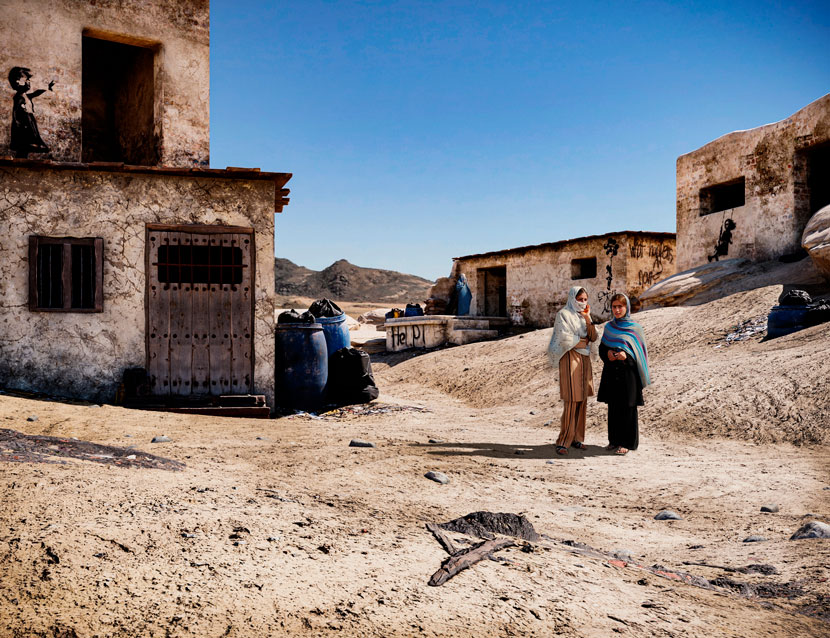 'Fainted Hope'
'Fainted Hope'
Let's talk about 'Fainted Hope', an evocative scene following the developments in Afghanistan and one of your most recent projects. At first glance, this seems like an unusual subject for an archviz studio. Please tell us about the original idea for the project and your decision to tackle this topic.
Dennis: Faced with the cruel reality everybody witnessed on TV, we were moved and felt responsible to act. As a young studio, we do not have a budget for social activism yet, but we wanted to at least do what we can, with our very own hands and minds.
Creating this image was our way to communicate and share our feelings. Our aim is to raise awareness and make people reflect on issues like the situation that Afghanistan is facing. You are right, it is unusual for an archviz studio to take a stand on social problems, but it should not be! It is our responsibility, not only as individuals but also as companies to address these kinds of issues and try to make a difference, starting with our direct surroundings.
Can you describe the design and composition of the scene in more detail?
Dennis: We knew exactly what we wanted to express, so we quickly brainstormed various iterations of what the scene should look like. The image was to grab the viewers' attention, evoke a feeling of affectedness, and make them reflect on the situation. The ambiance was inspired by several images we found of Afghan habitations. We aimed for realism, so we tried our best to capture the arid and vast landscapes we saw in these references and model authentic regional architecture. Finally, the young women are the focal point of the entire scene, they are quite literally in the middle of everything.
Renato: References were essential in helping us determine the size, features, and materials of houses in this part of the world. We selected colors and materials accordingly, as well.
What parts of the scenes were especially important to you, both from a visual/design as well as from a technical point of view?
Dennis: First and foremost, we wanted to tell a story that is both unambiguous and believable. The environment, the architecture, and especially the characters – everything had to look and feel as real and convincing as possible. The women’s postures and facial expressions are crucial in conveying this feeling of uncertainty and helplessness, so we put a lot of effort into their appearance.
What were some of the challenges you had to overcome and how long did it take you to complete the project?
Dennis: Until now we had only crafted CGI for modern architecture and product design. Creating an image of an abandoned and dilapidated scenery brought huge challenges in modeling and texturing. As we put a lot of effort into every detail, the project took around three weeks of stop-and-go execution from idea to completion.
Renato: Due to the particularity of the scene and how much it differs from the rest of our work, we had to get creative and work with what we had. There are not many assets or elements readily available, as you can imagine.
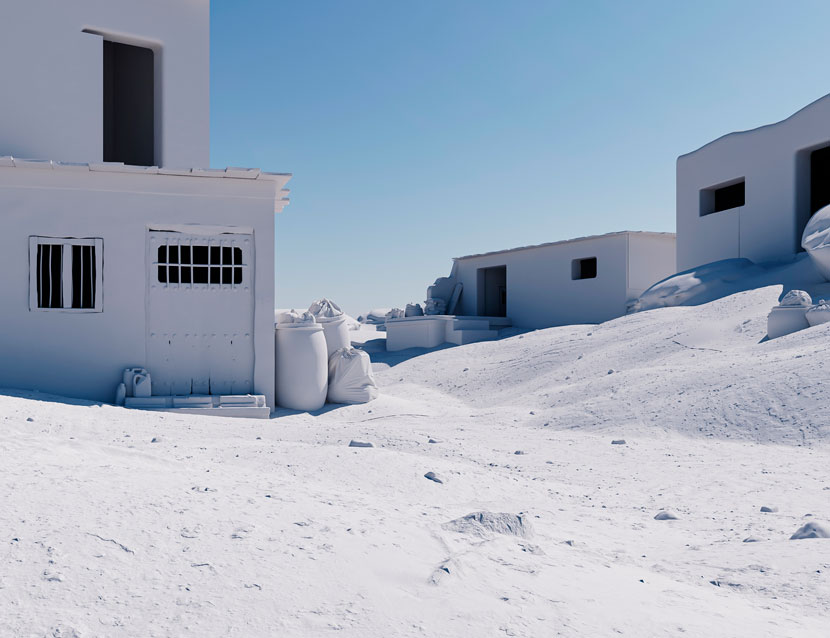 While the buildings depicted in 'Fainted Hope' are a long shot from the usual luxurious penthouses, the scene still prominently features architecture.
While the buildings depicted in 'Fainted Hope' are a long shot from the usual luxurious penthouses, the scene still prominently features architecture.
The houses are an integral part of the scene's visual narrative, an effect further emphasized by the various graffiti. Can you tell us about your experience in using architecture in this fashion?
Dennis: Taking on the challenge to create an environment that we are not used to in our daily business definitely meant stepping out of our comfort zone. Instead of slick and clean design, the imitation of raw reality was needed to create the image envisioned in our minds. Besides this unusual roughness inherent to the scene, taking architecture not as the central topic for a project presentation but rather as an additional tool to communicate feelings was new to us. This shift of focus widened our perspective on CGI and how it can be used.
Renato: We wanted the architecture to project the feelings that arose in us when receiving the news: uncertainty, abandonment, despair, anguish, and helplessness. The isolated buildings, the cracked and damaged plaster, the garbage next to the houses – all to reflect the harsh living conditions. We deliberately obscured and darkened the interior to heighten this sense of the unknown.
The street art specifically contrasts the fears of the young women and illustrates their wish to escape. The little girl attempting to reach the sky. A girl grasping at balloons, as if trying to fly away. Another girl taking off on her swing. Graffiti is an element of strong pictorial expression.
Why do you think this kind of personal and artistic expression is rarely found in professional archviz? Is the industry too commercialized to allow for such creativity?
Renato: It is commercialized, but that does not mean you cannot be creative. Of course, not everyone will pay you to make an image like 'Fainted Hope'; no one paid us to do it. Projects that feed off creativity are more often than not driven by intrinsic motivation, yet paid collaborations tend to come with certain requirements depending on the target audience. As CG artists we are always walking the fine line between art and business, and it is all about maintaining a healthy balance.
What software did you use to create this scene? Any plug-ins you found particularly helpful?
Renato: I used 3ds Max and Corona Renderer, and Photoshop for post-production. Some of the elements I placed with the help of a script called Image Composition Helper.
What feedback did you receive so far and how satisfied are you with the results yourself?
Dennis: Our community embraced this unconventional project with open arms. We witnessed discussions and meaningful reflections from the first day onward, which was exactly the impact we had hoped for. We personally feel inspired by the outcome and want to continue realizing projects that raise awareness and educate our followers. It is a privilege we have, and a responsibility we want to fulfill.
What is one thing you have learned from this project specifically that you can share with us?
Dennis: Putting effort into a project that is not paid in money but rather in passion is highly fulfilling and inspiring. Infusing an image with deeper meaning, coding emotion into every single pixel really makes a difference in the way people are touched by it. We were reaffirmed that while the numbers are important to sustain a business, it is a passion we thrive on.
 Another non-commercial render, 'Kaw's Home' was inspired by Makhno Studio's 'Mazanka Apartment'.]
Another non-commercial render, 'Kaw's Home' was inspired by Makhno Studio's 'Mazanka Apartment'.]
Please tell us about your overall experience with RebusFarm. Is there anything you especially like about our service?
Renato: I first took notice of RebusFarm back in 2020, when my mentor told me about it, and boy, oh boy, has it saved the studio since we started using it. It is pretty intuitive and easy to use, we especially love the communication with the support and marketing team. Thank you guys for your excellent work and for making us part of your community.
How much time did you approximately save by rendering with RebusFarm compared to your own machine(s)?
Renato: It depends. For static images, I would say we save around two to three hours on average, sometimes more. For animations, we are talking days, maybe even weeks. Either way, I'm grateful for what RebusFarm offers, and at a very reasonable pricing at that!
In closing, is there anything else you want to say? Any plugs, shoutouts, or upcoming projects you'd like to mention?
Dennis: Thank you so much for inviting us! It is an honor not only to be featured but to be able to talk about this very project we poured our hearts into. We hope your readers like our story, and maybe even feel inspired to start off – or continue – their own journey. Special thanks to everybody who believed in us from the early beginning, and to anyone who will cross paths with us in the future. DARQVIZ has just begun, and we are not going anywhere except forward!
Dennis, Renato, thank you so much for taking the time!
Keep up with DARQVIZ and their work here:
How to join ArtWanted!
Do you want to get featured in our ArtWanted! campaign and win 250 RenderPoints on top? Submit your work, rendered at RebusFarm, to This email address is being protected from spambots. You need JavaScript enabled to view it.! Visit our Art Wanted! page for more information.
>> Read more articles on our blog
Get started with your own renderings
